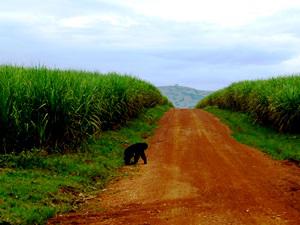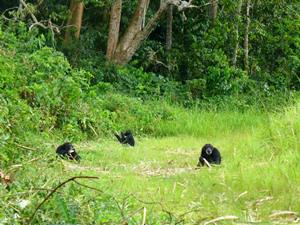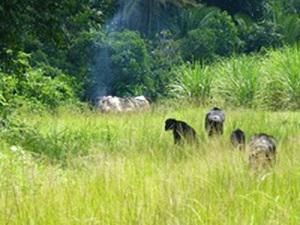Aimee Oxley
The project aims to identify the impacts of various human activities and habitat disturbances on chimpanzee socio-ecology and explore ways to improve human-ape co-existence.

Eddie crossing road between sugar, Nov 14.
Deforestation in Uganda is occurring at an alarming rate, fuelled by a rapidly growing population which relies heavily on subsistence agriculture, locally extracted fuelwood and increasingly on cash crops and employment from a local large-scale sugar factory. This results in increasing pressure on resident Endangered Eastern chimpanzee (Pan troglodytes schweinfurthii) communities, many of which now exist within landscape mosaics of forest fragments, riverine corridors, crop fields, roads and human settlements, including those that are the focus of this study. Whilst chimpanzees have been documented to persist in human-dominated environments, little is understood about how they are able to adapt to such rapid ecological alterations and thus what their long-term chances of survival are.

Feeding on sugar, forest edge.
Additionally, human-chimpanzee interactions become increasingly agonistic in nature as chimpanzees feed on the crops adjacent to their remaining forest habitat. This leads to negative perceptions towards them from farmers and breaks down progress in implementing conservation action to protect the forest and wildlife. Whilst crop-feeding and human-wildlife interactions have been increasingly documented, little progress has been made in finding effective solutions to improve the situation for either chimpanzees or humans.

Kasongoire males travelling on the forest edge, near cane guard hut.
This research will investigate chimpanzee responses to human activities and habitat disturbances aiming to highlight and predict which anthropogenic factors are of greatest concern to chimpanzee survival. Through recording data on chimpanzee behaviour, party composition and ranging whilst also measuring and monitoring habitat characteristics, fruit availability (wild fruit and adjacent cultivars) and human activities, the study will investigate the relationship between various habitat disturbance types and socio-ecological responses of chimpanzees. The study focuses on two chimpanzee communities in and around the Budongo Forest Reserve, Uganda, which vary in their degree of anthropogenic exposure and level of protection. One community inhabits protected, continuous forest with low exposure to human activities, and the other inhabits unprotected riverine forest fragments set in a landscape matrix of crops, roads and human settlements.
This information will be essential for effective conservation and land management planning: behavioural flexibility has yet to be factored in to conservation strategies and a systematic approach assessing their responses to different anthropogenic factors is currently lacking. The results of this study will feed into local and regional conservation strategies, including developing novel approaches to human-ape ‘conflict mitigation’. Meetings will be held with villagers and local chairmen and councillors to discuss the implications of the project’s results and explore ways to improve human-chimpanzee co-existence and custodianship of the forest.